|
|
|||
THIS WEEK at HILTON POND
15-21 September 2006
Installment #329---BHBD---Visitor #
(Back to Preceding Week; on to Next Week)
|
WHEN IT'S DREARY AND COLD |
|
CAESAR'S AMANITA:
A "TYPICAL" MUSHROOM When exploring the front yard at Hilton Pond Center last week, we encountered several three-inch red-orange objects that resembled billiard balls half-embedded in the grassy soil (below left). We recognized them as the tops of mushroom caps just beginning to poke up from the earth, and a visit to our library of natural history books indicated they were probably Caesar's Amanita, Amanita caesarea (possibly the eastern U.S. variety, A. jacksonii). We must first state there's not really any such thing as a "typical mushroom," AKA "toadstool." The fungi, of which mushrooms are just one type, are exceedingly diverse, from microscopic unicellular forms such as yeasts and molds to giant multicellular bracket fungi growing several feet wide on the trunks of trees. Even mushrooms themselves vary greatly in structure and appearance, but our Caesar's Amanita is what comes to mind when most folks hear the word "mushroom."
All text & photos © Hilton Pond Center The everyday, working part of a mushroom is seldom seen, mostly because it stays underground where moisture and darkness allow it to go about its task of decomposing dead organic matter. Exposed to light and air, a mushroom's delicate rootlike "hyphae" (also called "mycelia") quickly succumb to dessication or damage from ultraviolet light. A protected underground mycelium can be huge, however, radiating out many yards from its point of origin and--when conditions are just right--sending up an above-ground spore-bearing structure in the form of a "typical" mushroom. Since mushrooms are often produced by fresh, new growth at the outer edge of the mycelium, they sometimes appear as a "fairy ring."
Although its hyphae are hidden in the photo above, we can still see the mushroom's main anatomy. The most obvious part is the "cap," a big umbrella-like component that arises from a columnar "stipe." In Caesar's Amanita we also can see an "annulus"--a ragged ring left from when the still-unopened cap was attached to the stipe. Beneath the cap are parallel, paper-thin "gills" or "lamellae" that radiate out from the cap's center (close-up below). Each gill's two flat surfaces are covered by tiny microscopic structures that produce even tinier one-celled spores. Not all mushrooms have gills; on some, the underside of the cap is covered by a spongy material containing little "pores" in which the spores are produced. Knowing whether a mushroom has gills or pores is useful in identifying it, as is the presence or absence of an annulus on the stipe.
One structure that doesn't show in the photos just above but can be seen in the illustration of the just-emerging mushroom at the top of the page is the "volva," a thick membrane that protected the cap as the young fungus pushed through the soil. Sometimes parts of the volva remain on the cap and make it scaly, but in our Caesar's Amanita the cap is almost perfectly smooth. The photo below shows the volva in greater detail. We should note not all mushrooms have an obvious volva, so its presence or absence provides another clue to identification. Whether the inner ends of the gills are free of the stalk (as above) or attached to it is also a useful characteristic.
If one is really serious about identifying mushrooms, it's necessary to know the color of their spores, which come in all sorts of shades: brown, black, tan, pink, white, even "colorless." Since spores are microscopic, the only way to know their color is to collect a lot of them so their cumulative mass takes on a tell-tale hue. Collecting microscopic spores might seem like a difficult task, but it's actually quite easy; all one has to do is cut off the stipe, place the mushroom cap on a sheet of paper (below), and let gravity do its job.
A collection of spores done in this way is called a "spore print." Knowing ahead of time that amanitas usually have white spores, one night we placed the cap from our Hilton Pond mushroom on a sheet of black construction paper (above) and covered the whole thing with a plastic bowl to prevent air movements. (Obviously, one should use white paper if the mushroom is expected to have dark spores. Regardless of the color of the paper, do not lick your fingers after handling a mushroom cap--just in case it's a toxic species whose spores might be transmitted to your tongue.)
The next morning we removed the plastic cover and lifted the mushroom cap from the paper. We were rewarded by an intricate, ghost-like, artistically pleasing image--all painted by millions of minute white spores that dropped onto the paper during the night. Curiously, this spore print from our Caesar's Amanita appears three-dimensional, even though it formed on a flat piece of paper. The edges of many of the gills are outlined in black because no spores were deposited where gill edges touched the paper, and the circular shape of the stipe is obvious. (The blue coloration is an artifact of various dyes in the black construction paper; when they make black, they mix several other dyes together, so moist parts of the mushroom ended up creating a paper chromatogram as part of the spore print.) One of the most interesting parts of the mushroom's natural abstract art work is the brown fuzzy material on the left half of the print; this textured coloration appears to be spores that already have started to germinate.
A similar phenomenon appeared to be going on outside on one of the front yard mushrooms that had fallen over in the night (above). Exploding from its gills was a mass of hyphal growth, which at first we thought might be where where hundreds of the Amanita spores had found conditions right for germination. We always figured that when mushrooms died they simply disintegrated into a tired little puddle of water and ooze before being consumed by bacteria, but perhaps some mushrooms actually "cannibalize" themselves. In other words, maybe a sprouting mycelium can draw nutrients from the mushroom that produced its original spores, giving the new fungal growth a head start. After further deliberation, however, we concluded the mycelium in the photo above actually came from an entirely different soil fungus that had been waiting all its life for a big, succulent Caesar's Amanita to die. In any case, mushrooms--as "saprophytes" that live on dead things--play a valuable role in the environment, breaking deceased plants and animals into more basic compounds that can be used by new generations of living organisms. Caesar's Amanita actually has an even more complex lifestyle, since it is mycorrhizal; i.e., it has a collaborative symbiotic relationship with oaks and pines, whose rootlets it ensheaths with fungal hyphae. Fungal cells apparently help the tree roots absorb soil nutrients and water while the tree gives up relatively small amounts of food (photosynthesized sugars) and amino acids (a nitrogen source) to the mushroom.
Mushrooms also serve as food for diverse fauna, from Eastern Box Turtles to White-footed Mice to the larvae of carrion flies--even to miniscule, eighth-inch-long adult insects known as Pleasing Fungus Beetles (above). And, lest we forget, humans also eat mushrooms, with Caesar's Amanita once being a favorite of emperors of old. However, unlike some ancient Romans who ate the wrong toadstools, we're always careful when we encounter any mushroom in the front yard of Hilton Pond Center, knowing the differences in appearance between Amanita caesarea and some of its deadly relatives are very slight. Rest assured we don't eat wild mushrooms, mostly because we have no desire to be "typically" dead from eating a "typical" front yard mushroom.
All text & photos © Hilton Pond Center POSTSCRIPT: Mushroom taxonomy always seems to be in a state of major flux. Mycologists argue, lumping and splitting and re-splitting and re-lumping various species depending on the latest DNA results. Some authorities claim Caesar's Amanita, Amanita caesarea, occurs only in Europe, and that a similar North American species is/are actually A. hemibapha and/or A. jacksonii--collectively known as American Caesar's Amanita. Comments or questions about this week's installment?
Thanks to the following fine folks for recent gifts in support of Hilton Pond Center for Piedmont Natural History and/or Operation RubyThroat: The Hummingbird Project. Your contributions allow us to continue writing, photographing, and sharing "This Week at Hilton Pond." (See Support if you'd like to make a gift of your own.)
"This Week at Hilton Pond" is written & photographed You may wish to consult our Index of all nature topics covered since February 2000. You can also use our on-line Hilton Pond Search Engine at the bottom of this page. For a free, non-fattening, on-line subscription to |

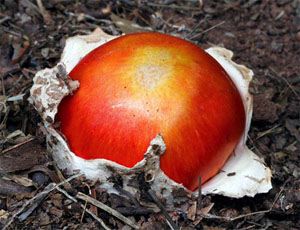 We remarked we couldn't make a final identification until the full mushroom appeared, allowing us to examine its structure and the spores it would contain. Within a few days the mushrooms did emerge completely (below), so this week's installment is devoted to a closer examination of Caesar's Amanita, a "typical" mushroom.
We remarked we couldn't make a final identification until the full mushroom appeared, allowing us to examine its structure and the spores it would contain. Within a few days the mushrooms did emerge completely (below), so this week's installment is devoted to a closer examination of Caesar's Amanita, a "typical" mushroom.
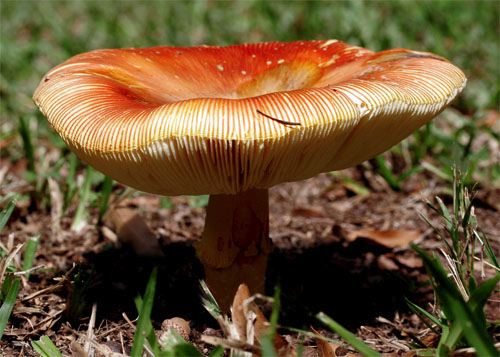

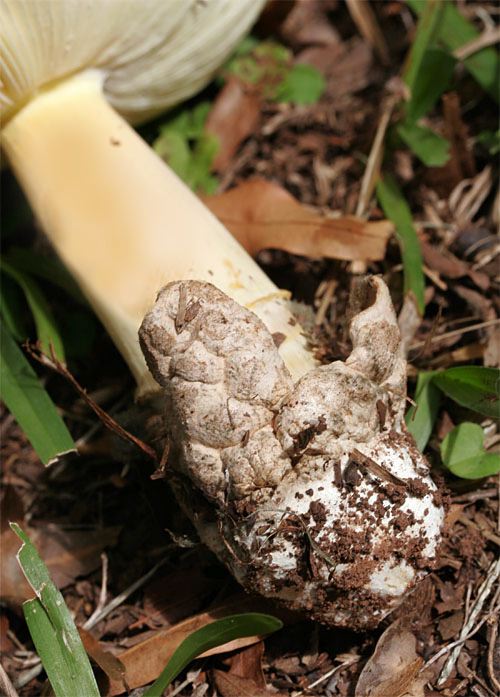
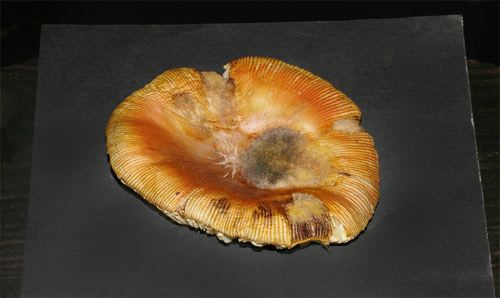
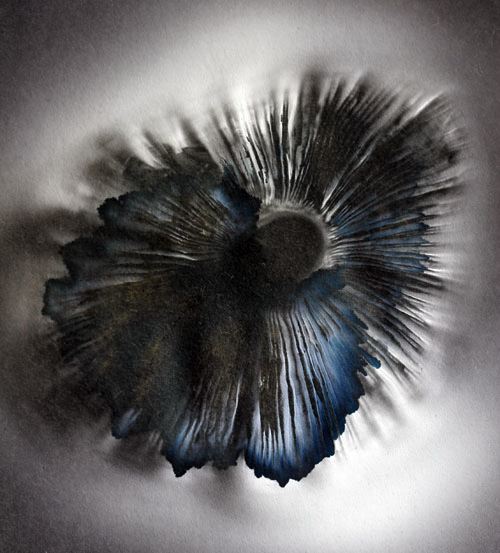

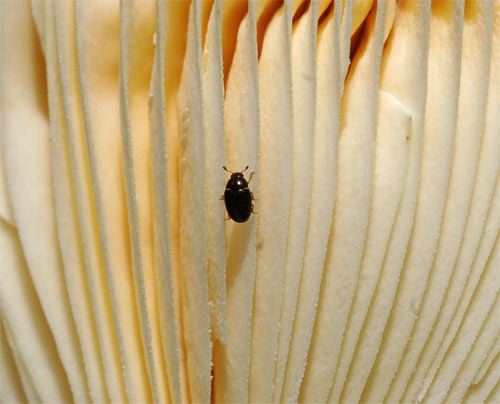


 Please report your
Please report your
